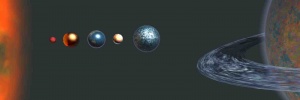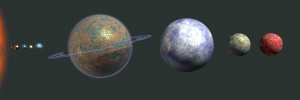Difference between revisions of "Planets of Errea"
Trismegistus (talk | contribs) |
Trismegistus (talk | contribs) |
||
| (11 intermediate revisions by the same user not shown) | |||
| Line 34: | Line 34: | ||
|- | |- | ||
|[[Azephassus (Planet)|Azephassus]] | |[[Azephassus (Planet)|Azephassus]] | ||
| − | |align="center"|4 | + | |align="center"|4 (—) |
|Reddish Gold Star | |Reddish Gold Star | ||
| | | | ||
|- | |- | ||
| − | |[[Pallathas (Planet)|Pallathas]] | + | |Asteroid Belt (was [[Pallathas (Planet)|Pallathas]]) |
| − | |align="center"|0 ( | + | |align="center"|0 (4) |
|Bluish Star | |Bluish Star | ||
| − | |[[Brom Jolom]] | + | |[[Brom Jolom]], Destroyed in deep antiquity |
|- | |- | ||
| + | |[[Aarothkopshaz]] | ||
| + | |align="center"|5 (5) | ||
| + | |Shining, Opalescent Star with Rings | ||
|[[Orion Pharaonicus (Planet)|Orion Pharaonicus]] | |[[Orion Pharaonicus (Planet)|Orion Pharaonicus]] | ||
| − | |||
| − | |||
| − | |||
|- | |- | ||
|[[Parkyo (Planet)|Parkyo]] | |[[Parkyo (Planet)|Parkyo]] | ||
| − | |align="center"|6 ( | + | |align="center"|6 (6) |
|Silver Blue Star | |Silver Blue Star | ||
| | | | ||
|- | |- | ||
|[[Asgion (Planet)|Asgion]] | |[[Asgion (Planet)|Asgion]] | ||
| − | |align="center"|7 ( | + | |align="center"|7 (7) |
|Bluish Green Star | |Bluish Green Star | ||
| | | | ||
|- | |- | ||
|[[Rhionacus (Planet)|Rhionacus]] | |[[Rhionacus (Planet)|Rhionacus]] | ||
| − | |align="center"|8 ( | + | |align="center"|8 (8) |
|Reddish Grey Star | |Reddish Grey Star | ||
| | | | ||
|- | |- | ||
|[[Orkybanth (Planet)|Orkybanth]] | |[[Orkybanth (Planet)|Orkybanth]] | ||
| − | |align="center"|9 ( | + | |align="center"|9 (9) |
| − | |Small, Dark Silver Star | + | |Small, Dark Silver Star; perhaps a planetoid |
| | | | ||
|} | |} | ||
| Line 76: | Line 76: | ||
This wandering star is big enough in size to be seen often even in the daytime star as a dull, blue-tinted star. The Planet Pallathas takes its orbit about the same distance from the Errean Sun as the asteroid belt is from our real-world sun. | This wandering star is big enough in size to be seen often even in the daytime star as a dull, blue-tinted star. The Planet Pallathas takes its orbit about the same distance from the Errean Sun as the asteroid belt is from our real-world sun. | ||
| − | Here below you can see the sun and the first six planets, from left to right: [[Arathrax (Planet)|Arathrax]], [[Nesbiria (Planet)|Nesbiria]], [[Asdar]], [[Azephassus (Planet)|Azephassus]], [[Pallathas (Planet)|Pallathas]], and [[Orion Pharaonicus]] with its rings. In this picture and the next, the planets are in scale to each other, but not in scale to distance. | + | Here below you can see the sun and the first six planets, from left to right: [[Arathrax (Planet)|Arathrax]], [[Nesbiria (Planet)|Nesbiria]], [[Asdar]], [[Azephassus (Planet)|Azephassus]] (perhaps once a satellite of Pallathas), (destroyed, now an asteroid belt, [[Pallathas (Planet)|Pallathas]]), and [[Orion Pharaonicus]] with its rings. In this picture and the next, the planets are in scale to each other, but not in scale to distance. |
| − | [[File:ErreanPlanets_Inner_001.jpg|thumb|300px|Artist's depiction of the inner Errean Planets]] | + | [[File:ErreanPlanets_Inner_001.jpg|thumb|300px|Artist's depiction of the inner Errean Planets. The fifth world, [[Pallathas (Planet)]], is mythical and today exists the asteroid belt in its place.]] |
Here below you can see all ten planets. After ringed [[Orion Pharaonicus (Planet)|Orion Pharaonicus]] are [[Parkyo (Planet)|Parkyo]], [[Asgion (Planet)|Asgion]], [[Rhionacus (Planet)|Rhionacus]], and wee little [[Orkybanth (Planet)|Orkybanth]] which probably shouldn't even be considered a planet. | Here below you can see all ten planets. After ringed [[Orion Pharaonicus (Planet)|Orion Pharaonicus]] are [[Parkyo (Planet)|Parkyo]], [[Asgion (Planet)|Asgion]], [[Rhionacus (Planet)|Rhionacus]], and wee little [[Orkybanth (Planet)|Orkybanth]] which probably shouldn't even be considered a planet. | ||
| Line 92: | Line 92: | ||
*[[Asdar]] | *[[Asdar]] | ||
*[[Eriu]] | *[[Eriu]] | ||
| + | *[[Hmœssite Astronomy]] | ||
| + | *[[Starsea]] | ||
[[Category:Astronomy]] | [[Category:Astronomy]] | ||
[[Category:Errean Planets]] | [[Category:Errean Planets]] | ||
| + | [[Category:Solar Systems]] | ||
{{stub}} | {{stub}} | ||
Latest revision as of 08:29, 8 September 2022
Known as the 'Wandering Stars,' the planets are regarded as other stars orbiting the sun by most modern-day astronomers. Everyday people of Asdar and many astronomers do not distinguish between a star and a world as seen from Asdar, considering all distant lights in the sky to be merely "stars."
Ancient Hmœssite astronomers first proposed the order of the planets around the sun as follows, from nearest to sun to the furthest:
Order of the Planets according to Hmœssite Astronomers
| Errean Planets | |||||
|---|---|---|---|---|---|
| PLANET | ORDER | APPEARANCE | ALTERNATIVE NAME | ||
| The Sun | 0 | Brilliant Sun | Errea, Erre, Eriu, Amrulon, other solar divinities | ||
| Arathrax | 1 | Small, Red-brown star | |||
| Nesbiria | 2 | Shiny, Silver Star | Gretla | ||
| Asdarah | 3 | Our own world | Asdar | ||
| Azephassus | 4 (—) | Reddish Gold Star | |||
| Asteroid Belt (was Pallathas) | 0 (4) | Bluish Star | Brom Jolom, Destroyed in deep antiquity | ||
| Aarothkopshaz | 5 (5) | Shining, Opalescent Star with Rings | Orion Pharaonicus | ||
| Parkyo | 6 (6) | Silver Blue Star | |||
| Asgion | 7 (7) | Bluish Green Star | |||
| Rhionacus | 8 (8) | Reddish Grey Star | |||
| Orkybanth | 9 (9) | Small, Dark Silver Star; perhaps a planetoid | |||
Names of the Planets
The above names are the Ebinóëse-Midretassene names which have been adopted throughout the Pallathantic. The ancient Hmœssite astronomers used names from their own Hmœssite tongue which are familiar to Hmœssite scholars even today.
Pallathas This wandering star is big enough in size to be seen often even in the daytime star as a dull, blue-tinted star. The Planet Pallathas takes its orbit about the same distance from the Errean Sun as the asteroid belt is from our real-world sun.
Here below you can see the sun and the first six planets, from left to right: Arathrax, Nesbiria, Asdar, Azephassus (perhaps once a satellite of Pallathas), (destroyed, now an asteroid belt, Pallathas), and Orion Pharaonicus with its rings. In this picture and the next, the planets are in scale to each other, but not in scale to distance.

Here below you can see all ten planets. After ringed Orion Pharaonicus are Parkyo, Asgion, Rhionacus, and wee little Orkybanth which probably shouldn't even be considered a planet.
Other Heavenly Bodies
See Also
| This article is a stub. It requires further development by the creator. |
